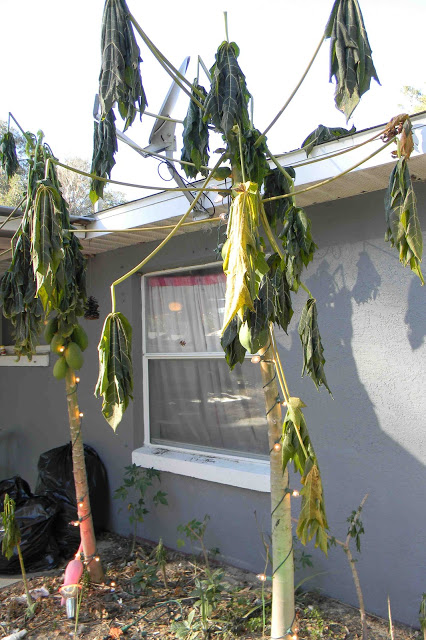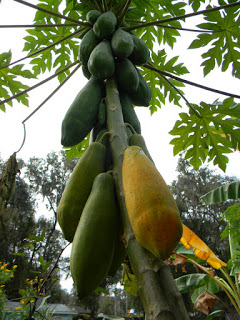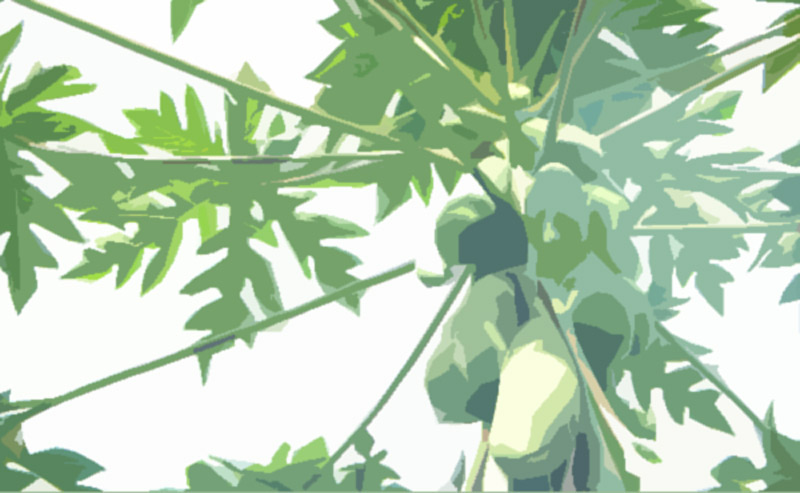Kate from Chiefland writes:
“I have grown huge papaya trees, this year the fruit came very early and now I have at least two dozen fruit, the largest almost 10 inches. My fear is (like many times before) the fruit will not ripen on the tree before the first frost. One year I had boatloads of huge green papaya that I picked due to frost and they just rotted. My question is are there any tricks I can use to get the fruit to ripen on the tree in the next month/before the first frost?”
Fruiting papaya trees getting hit by frost at just the wrong time? Yeah, I’ve been there.

Note the Christmas lights. That’s an old zone-pushing trick, but even that AND the trees being planted by a south-facing wall was not enough to save the fruit.
Papaya really can’t take the cold. And though they’re fast-growing “trees” and will start fruiting within a year of planting, they often start bearing in the summer and the fruit are still green as the fall comes.
And because they like warm weather and refuse to grow on cool days, their growth and the ripening of fruit slows and even stops in the fall.

And then comes winter – and frosts – and you lose the fruit. The trees will sometimes freeze back and regrow the next year but unless you have a mild winter the next season, you get the same problem again. The trees start to set fruit in summer, then fall comes and they slow down, then they lose their fruit in the winter.
It’s terrible!
I have picked the green papaya and eaten them (and shared some recipes here) but I like the ripe fruit better. Getting that fruit requires some planning, though, and so far as I know you can’t get the trees to ripen their fruit any earlier without keeping them warm in the fall.
There are some tricks that will work for getting papaya to bear out of their range – as you can read here – but you might have to get used to eating green papaya if a frost is on its way and the trees are loaded.
One possibility: if the trees are short enough, put 55-gallon drums of water at their bases before frost events, then cover the tree and the barrel with blankets through the night to trap in the heat. This is a trick I used on delicate trees in the past and got them to carry fruit through outside of their range. If it stays below for freezing for too long it won’t work, but for overnight freezes it works quite well.
Good luck.
Get my book Push the Zone if you want a bunch of other ideas on keeping tropical plants alive outside their “natural” range.



6 comments
My Latino and Latina friends take green fruit, and make very shallow cut on the skin, they say it will ripen them up. I have also had papaya candy, my friend’s mom cuts the green papaya in very thin strips, then she bakes them with clove, cinnamon, and sugar. (I’m sure there was more, but my palate is not that refined.) He said he used to eat it as a youth in Puerto Rico. I have to pick them somewhat green, if I don’t the squirrels eat them, although after a few days of fermentation on the tree, it is funny to see squirrels so drunk they can’t move.
If you trim off the smaller fruit and/or flowers, will it help the larger ones ripen quicker?
I’m not sure – possibly in warm weather, but when it’s getting chilly, they just quit doing anything.
I know their tall trees but could you cover them with something at night?
Yes, but it needs to be covered well. There are dwarf types that are rally good for covering.
I live in Hong Kong and my Asian papayas always ripen easily. But last year I brought some papaya seeds back from Cuba and they’ve grown great with massive fruits but they just won’t ripen. It’s nearing the end of the summer and not a single edible Cuban papaya has been grown. Why is Cuban papaya so different from Asian papaya?
Comments are closed.